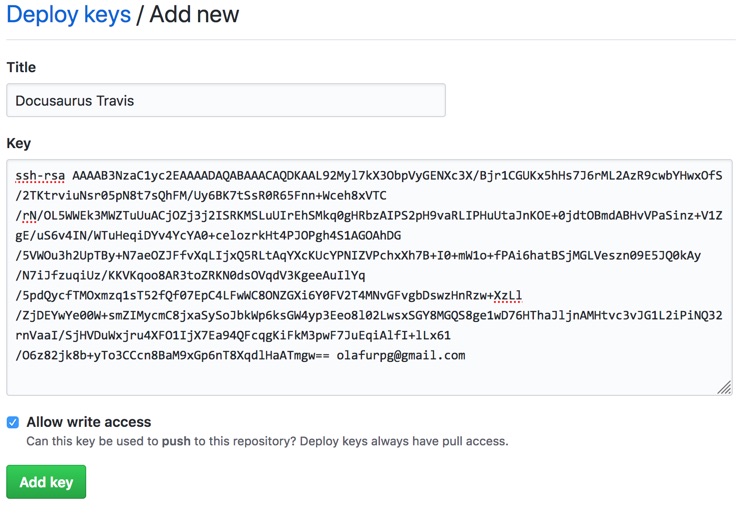Docusaurus
It's possible to use mdoc with Docusaurus to build documentation websites. Several projects already use mdoc in combination with Docusaurus:
Requirements
yarn: to run docusaurus.
Installation
First, install the sbt-mdoc plugin using the normal mdoc installation instructions.
Next, enable the mdoc.DocusaurusPlugin in addition to the mdoc.MdocPlugin
and define the moduleName setting to have your project name suffixed with
-docs.
// build.sbt
lazy val docs = project
.settings(
+ moduleName := "myproject-docs",
)
- .enablePlugins(MdocPlugin)
+ .enablePlugins(MdocPlugin, DocusaurusPlugin)
.dependsOn(myproject)
Next, setup a normal Docusaurus site following the Docusaurus installation instructions.
Once you have a Docusaurus site setup, update siteConfig.js to point
customDocsPath to the mdocOut directory with the generated mdoc output.
+ customDocsPath: "myproject-docs/target/mdoc",
Create static site
Generate a static website with docs/docusaurusCreateSite. This task runs
several steps:
sbt docs/mdoccd website && yarn install && yarn run build- creates
website/build/index.htmlthat redirects to/myproject/ - relativizes all links in the generated html so that it can be hosted on http://static.javadoc.io/
The static website gets generated in the website/build directory. You can copy
these files over to any static HTTP server to host your website.
Publish to GitHub pages locally
If you have a GitHub repository with a gh-pages branch, update siteConfig.js
to include the following information:
+ projectName: "mdoc",
+ organizationName: "scalameta",
Next, run docs/docusaurusPublishGhpages to publish the website to GitHub
pages. This task run several steps:
sbt docs/mdoccd website && yarn install && USE_SSH=true yarn publish-gh-pages
Publish to GitHub pages from CI
You can configure your Travis CI server to publish docs after merge into master. The Docusaurus docs already have excellent instructions for how to set this up. If those instructions work for you, then that's great! No need to read this section here. However, you prefer to use "deploy keys" over "personal access tokens because deploy keys are limited to individual repositories instead of per-account. If this sounds interesting, read ahead.
Deploy key
Open the "Deploy key" menu in your project settings: https://github.com/scalameta/mdoc/settings/keys. Press "Add deploy key".
Title: use "Docusaurus Travis".Allow write access: check the box, this is requires since we want to write to thegh-pagesbranch from CI.Key: generate a fresh SSH key usingssh-keygenmkdir ~/.github cd ~/.github ssh-keygen -t rsa -b 4096 -C "olafurpg@gmail.com" Enter file in which to save the key (/Users/ollie/.ssh/id_rsa): myproject Enter passphrase (empty for no passphrase): <ENTER, NO PASSPHRASE> Enter same passphrase again: <ENTER, NO PASSPHRASE> Your identification has been saved in myproject. Your public key has been saved in myproject.pub.It's important to use an empty passphrase so that the CI can install the key. Next, copy the public key and paste it into the GitHub "Key" field.
# macOS cat myproject.pub | pbcopy # Linux cat myproject.pub | xclip
Your screen should look like this

Environment variables
Next open the Travis CI settings panel for your project: https://travis-ci.org/scalameta/mdoc/settings.
Add the following values:
GITHUB_DEPLOY_KEY: the base64 encoded secret key. Note, the secret key is the file without the.pubextension# macOS cat myproject | base64 | pbcopy # Ubuntu (assuming GNU base64) cat myproject | base64 -w0 | xclip # FreeBSD (assuming BSD base64) cat myproject | base64 | xclip
.travis.yml
Next, update .travis.yml to trigger docs/docusaurusPublishGhpages on
successful merge into master and on tag push. There are many ways to do this,
but I recommend using Travis
"build stages". It's not
necessary to use build stages but they make it easy to avoid publishing the
website multiple times from parallel jobs. Define the test and release build
stages
stages:
- name: test
- name: release
if: (branch = master AND type = push) OR (tag IS present)
Next, define your build matrix with docs/docusaurusPublishGhpages at the end
jobs:
include:
# stage="test" if no stage is specified
- env: TEST="test"
script: sbt test
# release runs only if the previous stages passed
- stage: release
script: sbt docs/docusaurusPublishGhpages
For a complete example of the Travis configuration, see the .travis.yml in this project.
You're all set! Merge a PR to your project and watch the Travis job release the docs 😎
